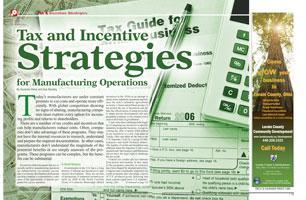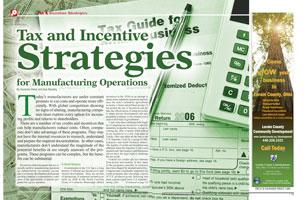
 Today’s manufacturers are under constant pressure to cut costs and operate more efficiently. With global competition showing no signs of abating, manufacturing companies must explore every option for increasing profits and returns to shareholders.
Today’s manufacturers are under constant pressure to cut costs and operate more efficiently. With global competition showing no signs of abating, manufacturing companies must explore every option for increasing profits and returns to shareholders.
There are a number of tax credits and incentives that can help manufacturers reduce costs. Often, companies don’t take advantage of these programs. They may not have the internal resources to research, understand and prepare the required documentation. In other cases, manufacturers don’t understand the magnitude of the potential benefits or are simply unaware of the programs. These programs can be complex, but the benefits can be substantial.
Several tax-related programs that are especially useful to manufacturing operations are outlined below. An attorney, accountant or economic development professional can help complete a comprehensive evaluation of the applicability of specific programs for a given operation.
A Brief History
Governments in the U.S. have a long history of offering tax incentives to spur desired development. There are records of discussions of industrial incentives as early as 1828 in the North Carolina House of Commons. Mississippi offered incentives in the 1930s in an attempt to attract more industrial operations and balance the state’s primarily agricultural economy. Citizen and political groups often protest the use of incentives and debate the effectiveness of using tax policy to shape private development, but new programs continue to be created every year at all levels of government.
Court cases have challenged the legality of targeting tax incentives to specific industries in specific locations. A case involving the offer of nearly $280 million in tax incentives to a new Jeep plant in Toledo, Ohio was taken all the way to the U.S. Supreme Court by a group of Ohio taxpayers and small business owners. The legality of credits and incentives was affirmed when the Supreme Court voted unanimously that taxpayer and businesses did not have the legal right to challenge the tax credit.
Federal tax credits are not immune from protest and scrutiny. In fact, many of the programs currently in existence have been shaped by international policy. Congress has consistently supported tax credit programs that encourage exports of U.S. produced goods, believing that more exports equal more U.S. manufacturing jobs. The World Trade Organization (WTO) has protested the use of such tax credits in the U.S., charging that these programs result in a permanent reduction in tax liability and violate the trade agreements between the U.S. and the WTO. As a result of the WTO’s protests, three major tax incentives were eliminated, the Domestic International Sales Corporation (DISC), the Foreign Sales Corporation (FSC) and the Extraterritorial Income Exclusion.
Consistently, Congress has acted to replace these programs to support U.S. manufacturing jobs. Incentives, while controversial, are here to stay. Businesses are overlooking a positive impact to the bottom line if they ignore potential incentives.
Federal Tax Credits for Manufacturers
State and local incentives are often the most well-known to businesses. Tax abatement programs, tax increment financing, industrial development bonds, training assistance and job creation tax credits are often discretionary and negotiable. When used to attract large projects, these programs generate a great deal of interest and press coverage. Federal programs tend to encourage investment and job creation through tax policy. While not as well known, these types of programs are available to any firm that qualifies.
Section 199 Manufacturing Deduction
The American Jobs Creation Act of 2004 was enacted to counteract the impacts of the WTO protest. The heart of the 2004 legislation is the Section 199 Manufacturing Deduction. Section199 provides a deduction equal to 9 percent of an eligible taxpayer’s income for income attributable to U. S. production activities. It is intended to preserve jobs and keep manufacturing operations in the U.S. Signed in October, 2004, Section 199 is a permanent deduction effective for taxable years beginning after December 31, 2004. Special rules are included for individuals and pass-through entities such as partnerships, S Corporations and Limited Liability Corporations.
The list of businesses which qualify for the deduction is quite long. It includes:
Manufacturers
Developers
Producers
Growers of agricultural products
Producers of qualified films
Producers of electricity, natural gas or portable water
Businesses that extract minerals
Contractors
Engineers
Architects
Installers
Other taxpayers that derive income from qualified production activities performed in the U.S.
The Act further defines the manufacturing activities that are eligible for the deduction. The definition is very broad; in fact nearly all U.S. manufacturers meet some part of the definition. According to the Act, manufacturing activities eligible for the deduction include any sale, exchange, rental, license, lease or other disposition of tangible property that is manufactured, produced, grown or extracted by the taxpayer either in whole or in significant part within the U.S.
The full 9 percent deduction is not available until tax years beginning in 2010. A phase-in period, from 2005 – 2009, allows for partial deductions as shown in the table below:
|
|
|
|
|
|
|
| 2% |
|
|
|
The deduction calculation can be quite complex. A good estimate of the deduction may be obtained through a simplified calculation in which the deduction is equal to the applicable percentage times the taxable income related to the manufacturing activities of the company.
The deduction is limited by two caps. It is limited to 9 percent of the lower of
qualified production activities income or
taxable income before the deduction.
The deduction is also limited to 50 percent of the taxpayer’s employee wages for the year.
Example of Section 199 Deduction
For a taxpayer with $1 million in taxable income that derives all of itsrevenue from qualified production activities performed within the U.S., the benefit is as follows:
|
|
|
|
|
|
|
|
|
|
|
|
|
|
|
|
|
|
|
|
*Assumes no limitation and annual federal tax liability without deduction of $340,000
In order to claim the deduction, the Form 8903 must be filed with the federal tax return.
The Interest-Charge Domestic International Sales Corporation (IC-DISC)
Although the original DISC (domestic international sales corporation) program was eliminated due to WTO protests in 1984, its predecessor, the IC-DISC, has been a tool available to U.S. manufacturers since the mid-1980s. It permits a deferral of U.S. tax on export sales. Unlike other federal tax credits targeted at increasing domestic manufacturing activity, IC-DISC has never been protested by the WTO. Because the IC-DISC pays annual interest expense on its tax-deferred assets, the WTO does not view the deferral as a subsidy.
Generally, if a company has gross foreign sales in excess of $1 million, formation of an IC-DISC should be considered. In addition, if a company can answer the following three questions affirmatively, it is likely that the establishment of an IC-DISC would be beneficial:
Does the company sell products or services produced in the U.S. outside the U.S.?
Is the company profitable for tax purposes?
Is the company closely held?
In order to form an IC-DISC, the exporting company (parent) must form a new corporation (sub) and elect tax-exempt IC-DISC status. The exporting parent then enters into a commission agreement with the new sub. The parent pays the new IC-DISC a sales commission on all export sales. IRS regulations allow for many different methods of calculating the sales commission, but two methods are most common:
4 percent of the revenue of the qualified export sales; or
50 percent of the taxable income of the qualified export sales.
Because the parent company directly owns the sub corporation, commission income received by the sub is converted to and taxed as a qualified dividend. The dividend is passed back through the parent company to its shareholders.
The IC-DISC has many tax benefits. It is essentially a non-taxable flow-through entity, so shareholders pay tax on a pro-rata share of income. The distribution is a qualified dividend taxed at the capital gains rate of 15 percent. IC-DISC designation has no impact on operations and is transparent to customers.
Example for a Limited Liability Company with IC-DISC
U.S. Export Sales | $60 million |
Sales commission | $2.4 million (4 percent of qualified export receipts) |
U.S tax reduction | $840,000 (35 percent of $2.4 million) |
Income to Shareholders | $2.4 million |
Tax on dividend | $360,000 (15 percent capital gains rate) |
Tax savings | $480,000 ($840,000 -$360,000) |
Research & Experimentation Credit
The Research & Experimentation federal tax credit is designed to encourage manufacturing companies to make technological improvements to products and processes. The credit has been in effect since 1981. Although Congress has attempted to make the credit permanent, these efforts have not yet been successful. Currently the credit is set to expire in 2008.
The definition of qualified research & experimentation activities is subject to interpretation. Rather than listing specific activities, the Act defines a 4-part test to establish eligibility. Expenditures must be:
Technological in nature – research must rely on science
Eliminate uncertainty – intent of research should be to make process more reliable
Process of experimentation – developing, testing and refining hypotheses
New or improved functionality – activities should relate to better performance, reliability, quality, etc.
The federal income tax credit is up to 6.5 percent of qualified expenses. The credit can also be taken retroactively on amended tax returns for up to three years. Eligible costs include W-2 wages, supplies used in qualified research and contract research expenses.
Cost Segregation – Maximizing Depreciation
IRS rules for depreciation are often overlooked as a source of tax savings. While most businesses receive tax savings through regular depreciation of buildings, many do not receive the full benefit allowed by the law. When a company constructs a new building or expands an existing building, the new construction is typically depreciated over 39 years. As much as 40 percent of the new construction cost may be classified as personal property, which is depreciated over a shorter time period using accelerated depreciation rules.
In order to take advantage of these potential savings, a company must undertake a cost segregation study. The study is used to identify and value types of property that may be eligible for accelerated depreciation, such as security systems, data wiring, power for computer systems, power for manufacturing equipment, equipment foundations, truck pads and sound masking systems.
The average net present value of additional cash flow is $200,000 for every $1,000,000 of 39-year property that can be reclassified. The IRS allows retroactive benefits to be recognized in one year without IRS consent or filing of an amended return.
Summary
A company should work closely with an attorney or tax advisor to determine what tax credits and savings strategies apply to their operation. While the investment in understanding the programs, gathering data and documenting costs may be significant, the impact to the bottom line can be worth the up-front costs.
